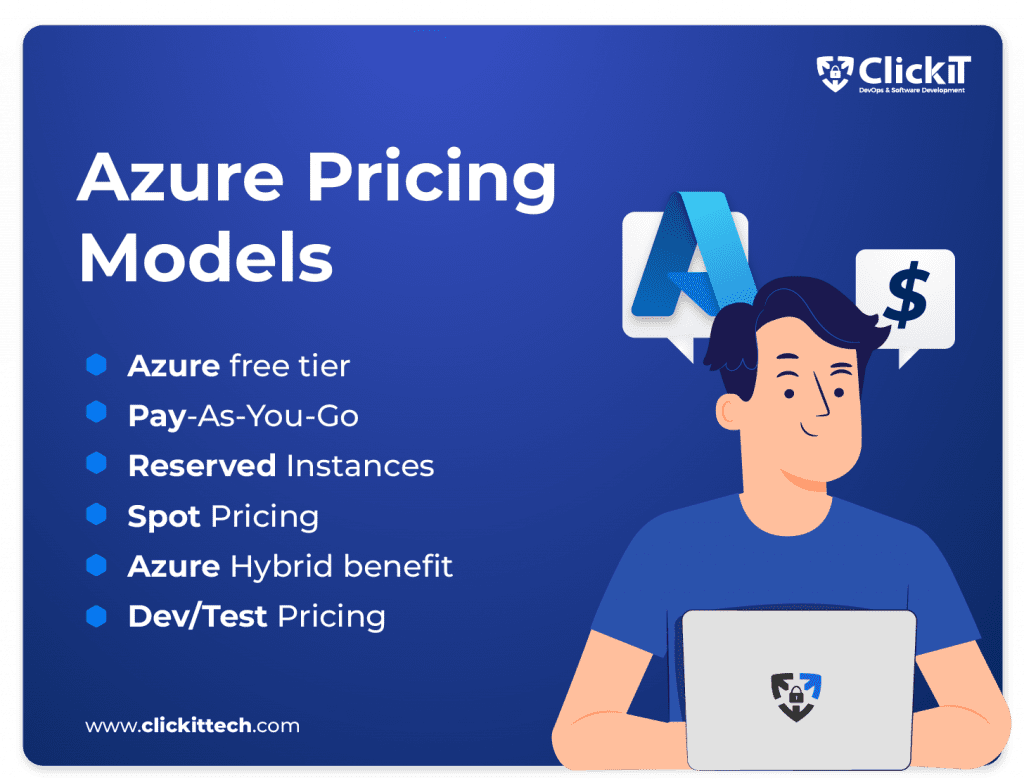Understanding Azure pricing is key to successfully leveraging the cloud platform’s benefits, as more businesses are moving their cloud operations to the Azure platform. This blog delves into Windows Azure hosting pricing structure to help businesses optimize cloud investments and increase ROIs.
- What is Azure?
- Components of Azure Pricing
- How Do Azure Pricing Models Work?
- Azure Pricing: Table of Azure Cloud Pricing
- Azure Saving Tricks
- Conclusion
- FAQs of Azure Hosting Pricing
What is Azure?
Azure is Microsoft’s cloud computing platform, offering various services, from virtual machines to storage and networks. It allows teams to leverage Microsoft-managed data centers to seamlessly build, deploy, and manage apps and services on the Azure cloud platform. The versatile platform supports various frameworks, programming languages, and tools. Flexibility, comprehensive service offerings, and robust pricing models are a few key aspects that make Azure a strong contender in the cloud space.
Why is Azure Popular in 2024?
Microsoft introduced Azure in 2008 as “Project Red Dog” at Microsoft’s Professional Developer Conference (PDC) and officially launched it in 2010. Initially, the platform was called Windows Azure, which was renamed Microsoft Azure in 2014. By 2018, Azure became available in 54 regions. Azure is the first primary cloud provider to launch two cloud regions in South Africa.
According to HG Insights, Microsoft earned a revenue of $96.2 billion in 2023, an increase of 17.7% over the previous year. In 2024, Azure customer base grew by 14.2% compared with 2023 and a global market share of 24% in Q1, 2024. Almost 350,000 customers across the globe purchase Azure cloud services.
Here are key reasons for the popularity of Azure:
- Integration with Microsoft Products: Azure seamlessly integrates with Microsoft products and services such as Office 365, Dynamics 365, and Windows Server. For enterprises that are already using Microsoft technologies, Azure becomes a preferred choice.
- Comprehensive Service Offerings: With more than 200 services covering simple storage solutions to advance AI & ML capabilities, Azure caters to business needs of all sizes and nature.
- High Availability and Low Latency: Azure has a global reach with data centers in multiple regions, which means high availability and low latency for organizations.
- Security and Compliance: The seamless integration with Windows services means Azure offers robust security features, complying with regular compliance standards.
Why Understanding Azure Pricing is Important for Businesses?
Businesses that use Azure cloud solutions should understand how Azure hosting pricing works. It helps in effective financial management and leveraging the full potential of the Azure cloud platform.
Here are a few reasons to do so:
Cost Management
Cloud costs can quickly escalate if the right resource allocation strategy and monitoring policy is not in place. For instance, unexpected costs arise from data egress sources or over-provisioning resources. By understanding Azure pricing storage, businesses can mitigate such surprises and optimize costs while better managing the infrastructure.
Budgeting and Forecasting
Understanding Azure cloud pricing helps organizations budget and forecast financially, and teams can allocate and monitor business infrastructure more efficiently.
Increased ROIs
By understanding Azure cloud pricing models, organizations can identify opportunities for cost savings and strategically leverage various pricing plans and diverse services to maximize the return on investment. For instance, organizations can commit to reserved instances or optimize resource usage to significantly save cloud costs.
Maximize Your Azure Potential with Expert Cloud Assessment
Components of Azure Pricing
To understand Azure cloud pricing, you should know the key components that reflect the diverse range of services the platform offers. Here are three key components of Azure pricing:
Sure, here’s a more summarized table:
| Category | Service | Pricing Factors |
|---|---|---|
| Compute | Virtual Machines (VMs) | RAM, CPU, specialized hardware (e.g., GPUs) |
| App Services | Service plan (compute resources allocated) | |
| Azure Kubernetes Service (AKS) | VMs in the cluster, additional services used | |
| Azure Functions | Number of executions, execution time, memory consumption | |
| Storage | Blob Storage | Data stored, frequency of access, operations performed |
| Azure Files | Storage capacity, performance tier, transactions | |
| Disk Storage | Disk type, size, number of transactions | |
| Managed Disks | Disk type, size | |
| Networking | Virtual Network (VNet) | Components within the network (NSGs, load balancers) |
| Bandwidth | Amount of outbound data, destination | |
| Load Balancer | Load balancing rules, data processed | |
| VPN Gateway | Gateway type, connection duration, throughput | |
| Content Delivery Network (CDN) | Data transferred out of CDN, number of requests |
Compute
Compute services provide the processing power for applications and workloads on a cloud platform. Azure pricing for compute services depends on various factors.
- Virtual Machines (VMs): Azure offers various VM types and sizes that can be billed on a pay-as-you-go basis or can be reserved for one to three years for cost savings. The price of the VM depends on various factors such as RAM, CPU, and specialized hardware like GPUs.
- App Services: App services are managed services that allow teams to host web apps, mobile backends, and RESTful APIs. The price varies with the chosen service plan which determines the amount of compute resources to be allocated.
- Azure Kubernetes Service (AKS): Azure Kubernetes Service is a managed service that lets you create and manage Kubernetes clusters and containerized apps in Azure. The price covers the VMs included in the cluster and any additional services used.
- Azure Functions: Azure Functions is a serverless computing offering for Azure. The price depends on the number of executions, execution time, and memory consumption.
Storage
Azure hosting pricing storage offers multiple solutions suitable for a variety of storage needs. Here are details of Azure pricing storage:
- Blob Storage: Blog storage is used for storing unstructured data such as binary data and text. The pricing varies with the amount of data stored, frequency of data access, and operations performed on the data.
- Azure Files: This type of storage is used for fully managed file shares in the cloud that can be accessed via NFS protocols, SMB, and RESTful APIs. The pricing is based on the provisioned storage capacity, performance tier, and transactions.
- Disk Storage: This storage model is used for persistent storage of VMs in Standard (HDD) and Premium (SSD) options. The price is based on the disk type, size, and number of transactions.
- Managed Disks: This storage option simplifies disk management. It abstracts storage account management for this purpose. The price is based on the type and size of the disks.
Networking
Azure offers networking services that help in connectivity and security for applications and services. When it comes to Microsoft Azure pricing, networking services pricing is multifaceted.
- Virtual Network (VNet): while there are no charges to create a virtual network in Azure, you might incur charges for components such as Network Security Groups (NSGs) and load balancers within the virtual networks.
- Bandwidth: Azure does not charge you for the inbound data transfer. However, outbound data transfer is charged based on the amount of data and the destination.
- Load Balancer: Azure offers both standard and basic load balancers. The price of load balancers depends on the load balancing rules and the amount of data processed.
- VPN Gateway: Azure VPN Gateway pricing is based on the gateway type, duration of connection, and throughput.
- Content Delivery Network (CDN): The pricing for Azure CDN services is based on the data transferred out of a CDN and the number of requests.
Organizations can effectively plan and manage their Azure expenditures by understanding how the pricing of these components is structured. Failing to do so can significantly impact overall costs.
How Do Azure Pricing Models Work?
Azure offers a variety of pricing models to accommodate diverse business needs and budgets. Here are the primary pricing models:

Azure Free Tier
Azure offers a free tier for users to explore and experiment with Azure cloud services. It is very beneficial for small businesses and individuals to try cloud services with financial commitments.
This free tier includes the following options:
- Free Service for 12 Months: Azure offers certain services for free for limited usage for 12 months. For instance, users can use Azure Virtual Machines, SQL Database, and Blob Storage for free.
- Always Free Services: Azure offers services such as Azure Functions and Event Grid with free tiers for an indefinite period. However, they come with monthly usage limits.
- $200 Credit: Azure offers a $200 credit for new users for the first 30 days to try Azure services.
Pay-As-You-Go
With a pay-as-you-go pricing model, Azure charges users for the actual usage of Azure services. It offers the flexibility for users to scale resources on-demand while only paying for the resources used. There are no upfront payment or termination charges. As the billing is done monthly, organizations can easily track and manage expenses. This Azure hosting pricing model is beneficial for businesses with fluctuating workloads.
Reserved Instances
Azure allows users to reserve virtual machines for one to three years to save costs up to 72% compared to PAYG pricing. With fixed costs, organizations can predict costs that help in budgeting and forecasting. Azure allows users to switch between VM sizes within the same family during this period. For businesses with predictable workloads and long-term resource requirements, RIs are a great choice.
Spot Pricing
Spot pricing allows users to purchase unused Azure instances at discounted rates. Spot VMs are significantly cheaper than standard VMs. However, Azure can reclaim them on short notice. This is beneficial for businesses with limited budgets and interruptible workloads.
Azure Hybrid Benefit
Azure Hybrid Benefit allows organizations to use the existing on-premise licenses of SQL Server and Windows Server with Software Assurance to save costs on Azure. While teams can seamlessly integrate on-premises licenses with Azure services, they can save costs up to 85% on SQL database and Azure virtual machines reusing existing licenses. This is beneficial for businesses with existing Microsoft licenses and looking to extend the infrastructure to the cloud.
Dev/Test Pricing
Azure offers special pricing for running development and testing environments in the Azure cloud. There are no additional software charges for Microsoft software on Dev/Test VMs. Windows and SQL Server VMs come with discounted rates. It helps businesses manage costs during the application development lifecycle.
Azure Pricing: Table of Azure Cloud Pricing
| Azure Service | Description | Region | Pricing |
| Virtual Machines (VMs) | Compute instances of various sizes and configurations | East US | Starting at $0.0105/hour for B1s (1 vCPU, 1 GB RAM) |
| Azure App Service | Managed platform for web and mobile apps | East US | Starting at $0.075/hour for Basic Plan |
| Azure Blob Storage | Object storage for unstructured data | East US | For First 50 TB/month – Hot: $0.021/GB, Cool: $0.015/GB, Archive: $0.00099/GB |
| Azure SQL Database | Managed relational database service | East US | Starting at $0.038/(vCore-hour)for Standard Series (Gen-5) |
| Azure Cosmos DB | Globally distributed NoSQL database | East US | Starting at $0.008/hour for 400 RU/s provisioned throughput |
| Azure Kubernetes Service (AKS) | Managed Kubernetes cluster | East US | Charges based on underlying VM instances ( $0.10 per cluster per hour for for standard tier) |
| Azure VPN Gateway | Secure cross-premises connectivity | East US | Basic: $0.04 per hour |
| Azure Functions | Azure serverless compute service | East US | $0.000016/GB-s, free tier includes 1 million executions per month |
| Azure Load Balancer | Distributes network traffic across multiple VMs | East US | Basic: Free, Standard: $0.025/hour + data processing costs |
| Azure CDN | Content delivery network for distributing content | East US | Starting at $0.081/GB for zone 1 |
Azure Saving Tricks
Understanding Azure hosting pricing helps you leverage Azure cloud benefits cost-effectively. Here are some of the cost-saving tricks to follow with the Azure platform:
- Choose different plans for different workloads. For instance, utilize the Azure Free Tier 12-month free services for development, testing, and learning, use the Reserved Instances (RIs) for predictable workloads, and Spot VMs for interruptible workloads.
- Optimize azure pricing storage by using Blob Storage Tiers based on access patterns. For instance, move infrequently used data to cooler or archive tiers while keeping frequently accessed data in the hot tier.
- Right-size your VMs based on workload requirements and actual performance to avoid overpaying for unnecessary resources.
- Implement Azure Autoscale feature to automatically adjust the number of VMs based on demand and avoid over-provisioning and paying for idle resources.
- Use Azure Cost Management and Billing tools to monitor and analyze resource usage and spending patterns to identify cost-saving opportunities.
- Shut down VMs, databases, and other resources that are not in use. You can write an automation script to shut down specific resources outside business hours.
- Use CDN for content delivery, minimize data transfer between regions, and optimize data egress strategies.
- Organize and track costs by departments, projects, and environments using tags and groups. Set up cost alerts to receive alerts when spendings reach a predefined threshold. It will help you to stay within your budget.
If you are still looking for more choices about Cloud costs, you can read our blog on AWS Pricing.

Conclusion
Understanding and optimizing Azure hosting pricing is important for businesses to fully leverage the cloud platform. Azure offers various pricing models catering to different usage patterns and financial considerations.
By getting familiarized with core components such as Compute, Network, and Storage, organizations can clearly understand how Microsoft Azure pricing works and make informed decisions on resource provisioning and cost management. In addition to implementing cost-saving strategies, organizations should monitor usage and set up alerts to maximize returns on Azure investment.
FAQs of Azure Hosting Pricing
The size of a VM, type, usage duration, region where the VM is deployed and any enabled features are some factors that influence the cost of running a VM on the Azure platform.
Spot VMs are an appropriate choice for workloads that are non-critical, flexible, and can tolerate interruptions. Stateless applications, batch processing, and development/testing environments are a few examples wherein Spot VMs are most effective with reduced prices.
With a PAYG pricing model, there is no upfront commitment and users are charged monthly for the consumed resources. The cost is based on the number of hours a VM runs, the amount of data stored, and number of transactions performed, etc.









